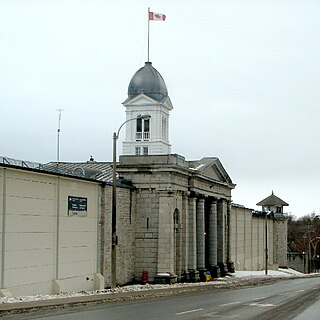
Kingston Penitentiary is a former maximum security prison located in Kingston, Ontario, Canada, between King Street West and Lake Ontario.

Risdon Prison Complex is an Australian medium to maximum security prison for males located in Risdon Vale near Hobart, Tasmania. The facility is operated by the Tasmanian Prison Service, an agency of the Department of Justice of the Government of Tasmania. The facility accepts criminals convicted under Tasmanian and/or Commonwealth legislation.

The Correctional Service of Canada, also known as Correctional Service Canada or Corrections Canada, is the Canadian federal government agency responsible for the incarceration and rehabilitation of convicted criminal offenders sentenced to two years or more. The agency has its headquarters in Ottawa, Ontario.

The Cellular Jail, also known as Kālā Pānī, was a British colonial prison in the Andaman and Nicobar Islands. The prison was used by the colonial government of India for the purpose of exiling criminals and political prisoners. Many notable independence activists, including Diwan Singh Kalepani, Yogendra Shukla, Batukeshwar Dutt, Shadan Chandra Chatterjee, Sohan Singh, Veer Savarkar, Hare Krishna Konar, Shiv Verma, Allama Fazl-e-Haq Khairabadi, and Sudhanshu Dasgupta were imprisoned here during the struggle for India's independence. Today, the complex serves as a national memorial monument.

Mississippi State Penitentiary (MSP), also known as Parchman Farm, is a maximum-security prison farm located in the unincorporated community of Parchman in Sunflower County, Mississippi, in the Mississippi Delta region. Occupying about 28 square miles (73 km2) of land, Parchman is the only maximum security prison for men in the state of Mississippi, and is the state's oldest prison.

A super-maximum security (supermax) or administrative maximum (ADX) prison is a "control-unit" prison, or a unit within prisons, which represents the most secure level of custody in the prison systems of certain countries.
The blanket protest was part of a five-year protest during the Troubles by Provisional Irish Republican Army (IRA) and Irish National Liberation Army (INLA) prisoners held in the Maze prison in Northern Ireland. The republican prisoners' status as political prisoners, known as Special Category Status, had begun to be phased out in 1976. Among other things, this meant that they would now be required to wear prison uniforms like ordinary convicts. The prisoners refused to accept that they had been administratively designated as ordinary criminals, and refused to wear the prison uniform.

The State Correctional Institution – Graterford, commonly referred to as SCI Graterford, known prior as Eastern Correctional Institution, Graterford Prison, Graterford Penitentiary, and the Graterford Prison Farm, was a Pennsylvania Department of Corrections prison located in Skippack Township, Montgomery County, Pennsylvania, near Graterford. The prison, located on Graterford Road off of Pennsylvania Route 29, was about 31 miles (50 km) northwest of Philadelphia.

Detention is the process whereby a state or private citizen lawfully holds a person by removing their freedom or liberty at that time. This can be due to (pending) criminal charges preferred against the individual pursuant to a prosecution or to protect a person or property. Being detained does not always result in being taken to a particular area, either for interrogation or as punishment for a crime. An individual may be detained due a psychiatric disorder, potentially to treat this disorder involuntarily. They may also be detained for to prevent the spread of infectious diseases such as tuberculosis.

The United States Penitentiary, Terre Haute is a high-security United States federal prison for male inmates in Terre Haute, Indiana. It is part of the Federal Correctional Complex, Terre Haute and is operated by the Federal Bureau of Prisons, a division of the United States Department of Justice. USP Terre Haute houses a Special Confinement Unit for male federal inmates who have been sentenced to death as well as the federal execution chamber. Most inmates sentenced to death by the U.S. federal government are housed in USP Terre Haute prior to execution, with few exceptions. FCC Terre Haute is located in the city of Terre Haute, 70 miles (110 km) west of Indianapolis.

The Hague Penitentiary Institution is a Dutch prison that is part of the Judicial Institutions Department of the Ministry of Justice. It can accommodate more than 1,000 detainees and consists of two locations, at Zoetermeer and Scheveningen. The Zoetermeer location is for Systematic offenders and the Scheveningen location serves as a Penitentiary Psychiatric Center, the 'open design' Limited Secured Installation and Judicial Medical Center. A special independent unit in the Scheveningen location serves as a United Nations Detention Unit (UNDU) for international offenders where they remain in pre-trial detention under the responsibility of the United Nations like suspects of the International Criminal Tribunal for the former Yugoslavia (ICTY) and of the International Criminal Court (ICC).
F-Type-Prisons, officially called F-type High Security Closed Institutions for the Execution of Sentences, are high-security prisons designated by Turkish Law 5275 on the Execution of Sentences.

Nieuw Vosseveld is a prison in Vught, Netherlands, part of the Custodial Institutions Agency of the Ministry of Justice and Security within the Dutch criminal justice system. Penitentiaire Inrichting Vught is now the general term used instead of Nieuw Vosseveld. Part of Nieuw Vosseveld is a maximum security prison; it holds some of Europe's most dangerous criminals, including Mohammed Bouyeri and Ridouan Taghi.

Fleury-Mérogis Prison is a prison in France, located in the town of Fleury-Mérogis, in the southern suburbs of Paris. With more than 4,100 prisoners, it is the largest prison in France. It is operated by the Ministry of Justice.

The Richmond General Penitentiary was a prison established in 1820 in Grangegorman, Dublin, Ireland as an alternative to transportation. It was part of an experiment into a penitentiary system which also involved Millbank Penitentiary, London. Richmond and Millbank penitentiaries were the first prisons in the United Kingdom of Great Britain and Ireland to specialise in reform rather than punishment. The building was designed by the architect Francis Johnston and decorated by George Stapleton. The building ceased to be a penitentiary in 1831, and later became part of the Richmond Asylum.
A prison is a place where people condemned to a custodial sentence or awaiting their trial are held against their will. Prisons are also used to try to reintegrate inmates into society in order to prevent recidivism. French prisons are overflowing and the penitentiary personnel is understaffed. In 2003 the European Committee for the Prevention of Torture (CPT), an organ of the European Council reported "inhumane and degrading treatment" in French prisons.

Norway's criminal justice system focuses on the principles of restorative justice and the rehabilitation of prisoners. Correctional facilities in Norway focus on maintaining custody of the offender and attempting to make them functioning members of society. Norway's laws forbid the use of torture and other cruel, inhuman, or degrading treatment as punishment. Prison conditions typically meet international standards, and the government permits visits by human rights observers. The system is considered to be transparent, and prisoners are represented by an ombudsman, an official appointed to investigate individuals’ complaints against public authority.

The penal system of Hong Kong, with its colonial tradition, is responsible for carrying out criminal penalties and the supervision and rehabilitation of former prisoners.
Howes v. Fields, 565 U.S. 499 (2012), was a decision by the U.S. Supreme Court that an interrogation of a prisoner was not a custodial interrogation per se, and certainly it was not "clearly established federal law" that it was custodial, as would be required by the Antiterrorism and Effective Death Penalty Act (AEDPA). Instead, the Court said, whether the interrogation was custodial depended on the specific circumstances, and moreover, in the particular circumstances of this case, it was not custodial. This decision overturned the rule of the Sixth Circuit, and denied the prisoner's habeas corpus petition.
















